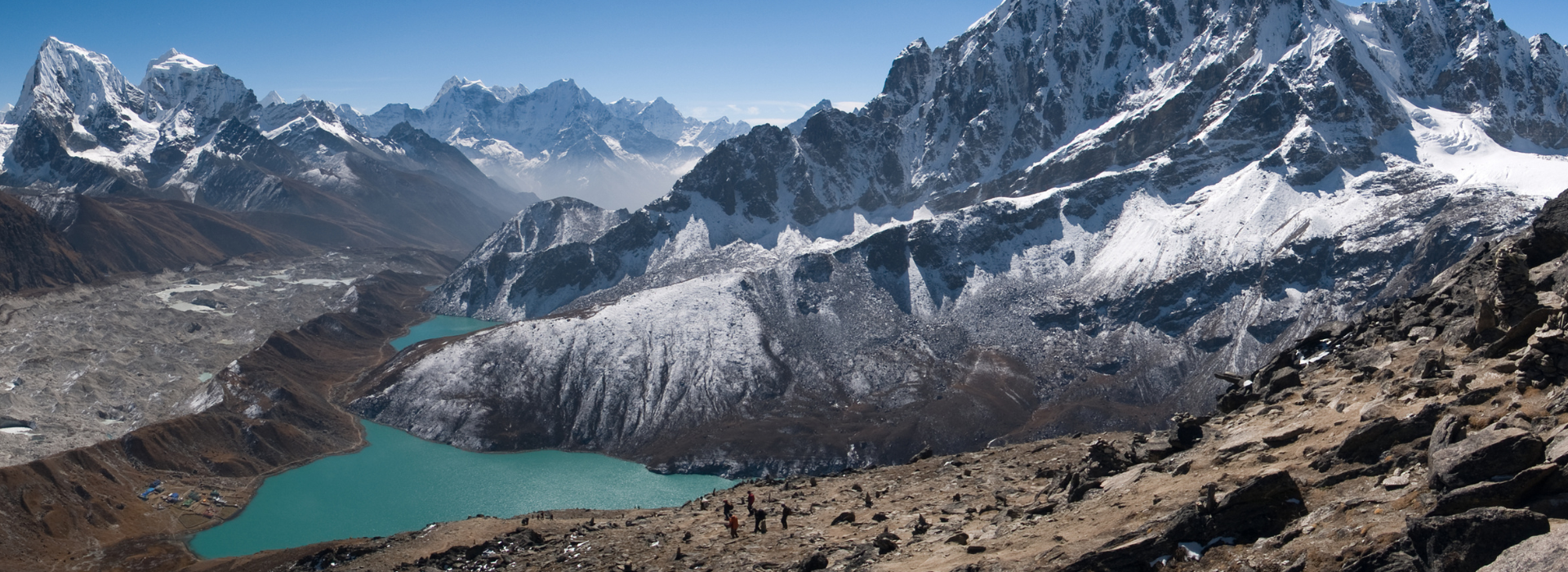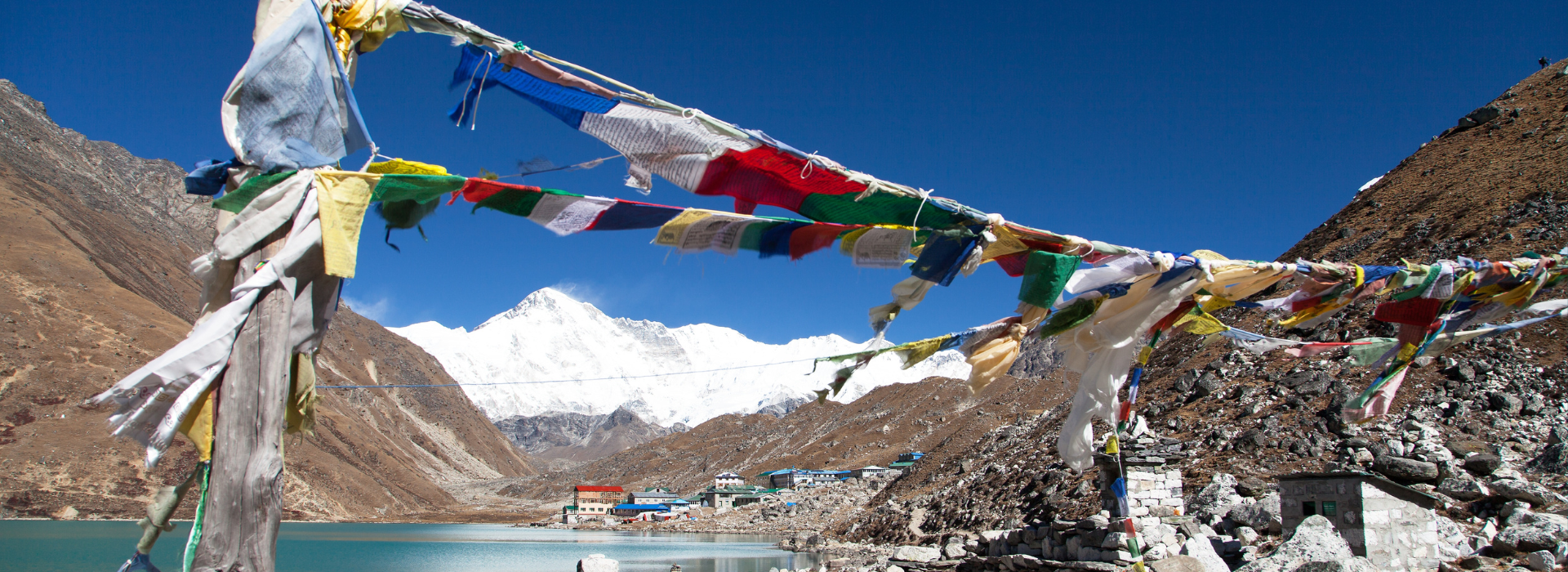Overview
We are the only company in the world who have an expedition leader and doctor on all Three Passes expeditions, while keeping group sizes sustainably small. Established in 2007, we offer high-altitude trekking and mountaineering in some of the most breathtaking locations around the world.
Trekking The Three Passes
Our 21-day Three Passes Trek itinerary takes a much less travelled, circular route to Everest Base Camp. Although tough, with a number of long days, this trek showcases the very best the Khumbu region has to offer, and is a truly rewarding experience for those with a bit more time and a good level of fitness. As a level 6 expedition, it is much more demanding than our “standard” 18-day Everest Base Camp trip (Level 4).
From Namche Bazaar we head west along an incredibly scenic but more remote course in a clockwise direction, following the traditional trading route with Tibet along the Bhote Khosi river. We visit the small villages of Thame and Lungden, making time to take in the traditional Nepalese way of life as we acclimatise. Thame is home to many famous Sherpas including Kami Rita Sherpa, who set a new record for the most visits to the peak of Everest in May of 2023. Each night we stay in locally run tea houses, enjoying the warm welcome of our hosts and the inviting heat of the stove as we remove our boots after a long day’s trekking. We spend two nights in Gokyo village, known for its glorious turquoise-coloured lakes, and reach Everest Base Camp (5,364m) on Day 14 of the trek. The final leg of our journey takes us over Kongma La, the highest of the three passes, to reach Chukkung, before we start the descent back to Lukla.
Although it is a trek all the way, there are many challenges and this expedition should not be underestimated. We cross three high passes; Renjo La (5,360m), Cho La (5,420m), and Kongma La (5,535m), all of which offer panoramic views across the imposing Himalayas. Optional, but absolutely worthwhile, is the chance to summit three (non-technical) peaks; Gokyo Ri (5,360m), Kala Patthar (5,550m), and Chukkung Ri (5,550m).
The Three Passes trek is ideal for those with a good level of fitness and plenty of perseverance! We climb above 5,000m on seven occasions, so previous experience at this altitude is preferable. Treks like Kilimanjaro or Everest Base Camp are ideal experiences prior to taking on this expedition.
Note: The itinerary is subject to change due to the unpredictable nature of adventure travel. Adjustments may be necessary due to weather or other unforeseen circumstances.
Three Passes Expedition Costs & What’s Included
The total cost of trekking the Three Passes is highlighted above. You are required to pay a €399 deposit to secure your spot. A part payment of €1,000 is due six months prior to departure. You can pay the remaining balance by instalments or in full. All fees must be paid three months prior to departure.
Your fees include the following:
- Internal flights in Nepal
- Experienced expedition leader
- Experienced expedition doctor
- Training Weekend
- Earth’s Edge team of guides, cooks, and a full support team
- All accommodation based on twin sharing in hotels in Kathmandu and in tea houses elsewhere
- All meals and drinking water, except in Kathmandu and Ramechhap where accommodation is based on B&B
- A celebratory dinner
- Group transport throughout the expedition
- All group gear consisting of a fully stocked med kit including an oxygen tank
- Earth’s Edge Buff
Flights
Please consult us before booking your flights to ensure you arrive in time for the expedition briefing on the first day. It’s essential you do not miss this meeting.
Read our Three Passes Trek Blogs
Are you looking for even more information on this expedition? We have lots of extra insight into our Three Passes Trek on the blog.
Itinerary
Day 2
Arrive in Kathmandu.
↓
Arrive in Kathmandu in time for your expedition briefing. Overnight hotel.
Day 3
Transfer to Ramechhap. Fly to Lukla, trek to Phakding (2,610m), 3 hrs trekking.
↓
Transfer to Ramechhap in the early morning. Fly to Lukla and trek to Phakding.
Day 4
Trek Phakding to Namche Bazaar (3,440m), 8 hrs.
↓
A stunning day on the trail with views of Everest (8,848m), Lhotse (8,511m), Nuptse (7,879m), Ama Dablam (6,856m) and Taweche (6,542m) if the weather is clear.
Day 5
Acclimatisation Day.
↓
A full day in Namche Bazaar with an acclimitisation hike. Visit to the National Park museum with the option of visiting the Sherpa museum too.
Day 6
Trek Namche Bazaar to Thame (3,800m), 4-5 hrs.
↓
We trek to the small Sherpa village of Thame where some the world’s most famous mountaineers grew up, including Apa Sherpa and Tenzing Norgay.
Day 7
Trek Thame to Lungden (4,380m), 5-6 hrs.
↓
We trek along the Bhote Khosi (“River From Tibet”) up towards Lungden.
Day 8
Rest and Acclimatisation Day in Lungden.
↓
Another night in Lungden to ensure we are sufficiently acclimatised before our first high pass tomorrow.
Day 9
Trek Lungden to Gokyo via Renjo La Pass (4,790), 7-8 hrs.
↓
A big day, as we cross the first of our three high passes - Renjo La Pass (5,360m), en route to Gokyo village.
Day 10
Rest and Acclimatisation Day in Gokyo.
↓
A rest day with optional hikes to keep us busy, including Nepal’s longest glacier, Ngozumba.
Day 11
Ascend Gokyo Ri and trek to Dragnag (4,700m), 3-7 hrs.
↓
An early morning start and a steep three hour climb will bring us to the summit of Gokyo Ri (5,360m) for sunrise. Option to stay in Gokyo and rest until the afternoon. Descend to Dragnag.
Day 12
Trek Dragnag to Dzongla via Cho La Pass (4,830m), 8-9 hrs.
↓
A long and more challenging day towards our second high pass - Cho La (5,420m). A long and more challenging day on the trek. Descending to Dzongla.
Day 13
Trek Dzongla to Lobuche (4,940m), 4 hrs.
↓
A short and relatively easy day today to Lobuche. Relax for the afternoon in Lobuche before another big day tomorrow.
Day 14
Trek Lobuche to Everest Base Camp to Gorakshep (5,164m), 9 hrs.
↓
We climb to Gorakshep for lunch before reaching Everest Base Camp, a highlight of the expedition. Descend to Gorakshep.
Day 15
Ascend Kala Patthar. Trek Gorakshep to Lobuche (4,940m), 8-9 hrs.
↓
Optional sunrise hike to summit the trekking peak of Kala Patthar (5,550m). Return to Gorakshep for breakfast before retracing our steps back to Lobuche.
Day 16
Trek Lobuche to Chhukung via Kongma La Pass (4,700m), 8-9 hrs.
↓
We tackle our last high pass, the challenging Kongma La (5,535m). Descend into the beautiful Imja Valley to Chhukung.
Day 17
Ascend Chhukung Ri. Trek Chhukung to Pangboche (3,985m), 9-10 hrs.
↓
The final big challenge, an optional trek to the summit of Chhukung Ri (5,550m). After we descend to Chhukung, then to Pangboche. Overnight tea house.
Day 18
Trek Pangboche to Namche Bazaar (3,440m), 7-8 hrs.
↓
An easy descent to Tengboche, with close-up views of Ama Dablam. Then onto Namche Bazaar. You have some time for shopping in the afternoon.
Day 19
Trek Namche Bazaar to Phakding (2,610m), 4 hrs.
↓
Descend to the picturesque village of Phakding.
Day 21
Fly Lukla to Ramechhap, transfer to Kathmandu.
↓
We fly back to Ramechhap in the morning and transfer back to Kathmandu. Enjoy a celebratory meal in the evening. Overnight hotel.
Facts
The mountainous north of Nepal is home to eight of the world's ten tallest mountains, including the highest point on Earth, Mount Everest. It is also home to more than 240 peaks over 6,000m above sea level.
The people of the Khumbu region are called Sherpas, and have adapted to living at high altitude for generations. Sherpas are key sources of climbing expertise, advice, and help. Most Sherpas under the age of 50 tend to have a good level of English.
The traditional Sherpa village of Thame holds a particularly rich and great history. Most notably, it is home to many famous Sherpas including Kami Rita Sherpa, who set a new record for the most visits to the peak of Everest in May of 2023 with 28 ascents.
Thame also houses one of the oldest monasteries in the Khumbu region, which is known for its annual Mani Rimdu festival.
The Gokyo lakes are the world's highest freshwater lake system comprising of six main lakes, and are considered sacred by both Hindus and Buddhists.
Best time to trek to the Three Passes?
The best time to attempt your Three Passes Trek is in May or October. Early spring and winter may make the trail unpassable due to ice, and views are likely to be obscured by low clouds and fog.
What do you need to trek the Three Passes?
We have an extensive packing list detailing what you should bring with you while trekking the Three Passes.
How to prepare for the Three Passes Trek
We have classified the Three Passes Trek as a level 6 expedition. This is a relatively long trek, with an average of six hours of walking per day. We expect participants to have a very good level of fitness, and good stamina is essential. For many people, it will be the hardest physical challenge of their lives. The group moves at a comfortable pace and nobody is ever left behind. Nevertheless, it is your responsibility to contact us if you have any concerns regarding your level of fitness, health or ability to complete the trek. We recommend that you read our detailed document on the Three Passes before signing up.
 Certified B-Corp
Certified B-Corp
Earth's Edge is a certified B-Corp. In fact, we are the highest scoring B-Corp in Ireland. We are passionate about sustainable travel, bettering the lives of the people connected with the company and minimising our environmental impact.
Tree Planting
We plant 8 native trees in Nepal for each person that travels with us in partnership with Eden Reforestation Projects. If you would like to plant more, please contact info@earths-edge.com. Each extra tree costs €0.75 cents. Learn more about our tree planting project here.








 Certified B-Corp
Certified B-Corp


